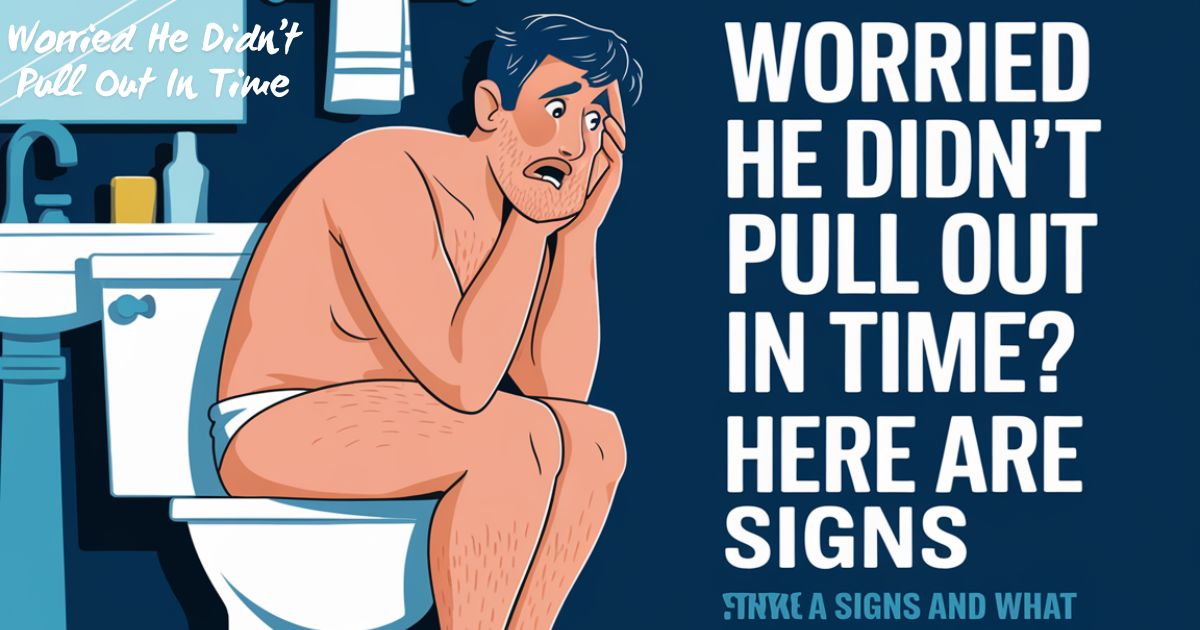Intimate moments can be exhilarating, but they sometimes don’t unfold as anticipated. One common concern for many couples is the effectiveness of the pull-out method.
If you’re anxious about whether he pulled out in time, this situation can be distressing, as it may heighten the risk of unintended pregnancy. Recognizing the signs and understanding the appropriate steps to take next is crucial in this scenario.
In this comprehensive guide, we’ll walk through 15 signs that he might not have pulled out in time and what actions you should consider if you find yourself facing this situation.
1. He Admitted It
One of the most direct indicators that he might not have pulled out in time is if he openly admits it. Honesty is fundamental in any relationship, and his admission reflects a level of responsibility and willingness to address the issue together. Having an open dialogue about what transpired allows both partners to discuss their feelings and plan the next steps.
In such situations, ensure the conversation is constructive. Focus on understanding each other’s perspectives and feelings. This dialogue can also foster greater intimacy, as navigating such delicate matters together can strengthen your bond.
2. Feeling Wetness
Experiencing wetness after sex can be a sign that he didn’t withdraw in time. This wetness could be a result of semen, indicating that he ejaculated inside you. While natural lubrication can contribute to the feeling of wetness, semen typically has a different texture and consistency.
If you find yourself unsure, it’s better to err on the side of caution. Taking this sign seriously can help you evaluate the situation more effectively. If you experience wetness and are uncertain about its origin, consider it a potential indicator that the pull-out method was unsuccessful.
3. No Time to Pull Out

Sometimes, the moment can be so intense that there simply isn’t enough time for him to pull out. If the intercourse was particularly quick and intense, he may not have had the opportunity to withdraw before ejaculation. The pull-out method demands precise timing, and in the heat of the moment, executing it perfectly can be challenging.
If the encounter felt especially passionate or rushed, the likelihood of him not pulling out in time increases. It’s important to recognize that intimacy can sometimes lead to spontaneous moments where decisions happen rapidly.
4. He Didn’t React Quickly
A critical aspect of the pull-out method is the need for quick reactions. If he didn’t respond promptly upon feeling he was about to ejaculate, this could be a sign that he didn’t pull out in time. Ejaculation can occur suddenly, and if he wasn’t mentally prepared or didn’t notice the signs in time, he may have been unable to withdraw effectively.
Being aware of each other’s bodies and reactions during intimate moments is vital. Partners should strive for mutual attentiveness to enhance the effectiveness of this method.
5. Lack of Communication
Effective communication is essential during intimate moments. If there was a lack of communication about when he was nearing ejaculation, it may have led to the failure of the pull-out method. Discussing and signaling when ejaculation is imminent helps both partners prepare adequately.
Without clear communication, the chances of a mishap significantly increase. Prioritize conversations about boundaries and signals to ensure both partners are on the same page during intimate moments.
6. Feeling of Ejaculation

Some women can sense when their partner ejaculates inside them. If you felt a sudden warmth or a distinct pulsing sensation, it might indicate that he didn’t pull out in time. This sensation can be quite unique and different from the usual feelings experienced during sex.
Trusting your body and recognizing these sensations can assist in determining whether he ejaculated inside you. If you experience a sudden change in feeling during intercourse, it’s important to take note of it as a potential sign.
7. He Wasn’t Sure
If he appeared unsure or hesitant about whether he pulled out in time, it’s prudent to assume that he might not have. Uncertainty often suggests that things did not go as planned. If he can’t confidently assert that he successfully withdrew, it’s wise to take precautions as if he didn’t.
Doubt and hesitation typically indicate that the pull-out method may not have been executed correctly. Addressing any uncertainty with an open discussion can help clarify the situation.
8. No Clear Withdrawal
If you didn’t feel a definitive withdrawal motion before he ejaculated, it’s possible he didn’t pull out in time. A clear withdrawal involves him pulling out well before ejaculation occurs.
The absence of a noticeable withdrawal can be a strong indicator that he didn’t pull out in time. Paying attention to these physical cues can help you assess what happened during your intimate encounter.
9. He Was Too Close
If he remained very close to you and didn’t create distance quickly, he might not have been able to pull out in time. Physical proximity can significantly influence the effectiveness of the pull-out method. The closer he is during ejaculation, the less likely he will be able to withdraw successfully.
Being aware of your positioning during intimate moments can contribute to better execution of the pull-out method. Discussing comfort levels and positioning can also enhance the overall experience.
10. You Didn’t Use Protection

Not utilizing any form of protection heightens the risk of pregnancy if he didn’t pull out in time. Options like condoms or other contraceptives offer an additional layer of safety. Relying solely on the pull-out method can be risky, and implementing additional protection can help reduce the chances of unintended pregnancy.
Consider discussing contraceptive options with your partner to find a method that suits both of your needs. Combining methods can enhance your overall protection against pregnancy.
11. He Wasn’t Paying Attention
If he seemed distracted or not fully engaged during the encounter, he might not have pulled out in time. Focus and awareness are crucial for the pull-out method to be effective. Distractions or a lack of concentration can lead to mistimed withdrawal.
Ensuring both partners are present and attentive can improve the effectiveness of this method. Creating an atmosphere of mutual engagement during intimate moments can enhance both enjoyment and safety.
12. He Didn’t Warn You
If he didn’t give you a heads-up that he was about to ejaculate, you might not have been prepared for him to pull out. Clear communication regarding timing is essential. A lack of warning can catch you off guard, making it difficult for you to anticipate and respond appropriately.
Establishing a system of signals or verbal cues can enhance your ability to react in real-time during intimate moments. Open discussions about preferences and comfort can improve overall communication.
13. You Felt a Sudden Change

A sudden shift in the rhythm or intensity of intercourse could signal that he didn’t pull out in time, suggesting that he ejaculated inside you. Being attuned to changes in dynamics can assist you in assessing the situation more accurately.
Recognizing these shifts can provide valuable insight into what transpired during your encounter. Taking note of your physical sensations can help you gain clarity on the situation.
14. He Wasn’t Experienced
If he lacks experience with the pull-out method, it’s possible that he didn’t pull out in time. Familiarity and practice can enhance the success of this method, while inexperience may lead to issues with timing and execution.
Having discussions about contraception and practicing together can improve the effectiveness of the pull-out method. Building confidence in each other can foster a greater sense of security.
15. You Have a Gut Feeling
Sometimes, your intuition may signal that something didn’t go as planned. If you have a strong gut feeling that he didn’t pull out in time, it’s important to trust yourself and take appropriate action. Your instincts can serve as a valuable guide in assessing the situation.
If you feel uneasy or uncertain, it’s wise to take precautions and address the potential risk of unintended pregnancy. Recognizing your feelings and taking them seriously is essential.
Click For More Information: The Ultimate Guide to Moving: wkyidcuim8w= moving:wkyidcuim8w= gif wallpaper
If you’re worried your partner didn’t pull out in time during sex, the most important thing to do is consider taking emergency contraception (the “morning after pill”) as soon as possible; this is especially crucial if you are not on any form of regular birth control or if you suspect ovulation is near.
Signs that might indicate a potential issue:
- Last-minute pull out:If your partner pulled out very close to ejaculation, there’s a higher chance of semen entering the vagina.
- Visible semen near the vaginal opening:This is a clear sign that some semen may have been released before withdrawal.
- Feeling of discomfort or unusual sensation during sex:While not always indicative of a problem, it might be a sign of unexpected penetration.
What to do next:
- Talk to your partner openly:Discuss your concerns and emphasize the importance of proper withdrawal technique if you choose to use this method.
- Access emergency contraception:
- Over-the-counter options: Most pharmacies sell emergency contraceptive pills like Plan B One-Step, which can be taken within 72 hours of unprotected sex.
- Prescription options: If you are past the 72-hour window, consult a healthcare provider for a prescription-based emergency contraceptive like Ella.
- Consider alternative birth control methods:If you are concerned about the reliability of the pull-out method, discuss other contraceptive options with your partner, like condoms, intrauterine devices (IUDs), or hormonal birth control.
Important points to remember:
- Time is crucial:The effectiveness of emergency contraception decreases significantly the longer you wait after unprotected sex.
- Consult a healthcare professional:If you have any questions or concerns about your situation, reach out to a doctor or nurse practitioner.
- Privacy and non-judgmental approach:Healthcare providers are trained to offer confidential and supportive advice regarding sexual health matters.
What to Do Next?

If you suspect he didn’t pull out in time, there are several steps you can take to manage the situation responsibly. Acting quickly and thoughtfully can help mitigate the risk of unintended pregnancy.
1. Stay Calm
First and foremost, try to remain calm. Panicking is not helpful, and it’s crucial to think clearly about your next steps. Taking a few deep breaths and centering yourself can allow you to approach the situation with a clearer mind. Stress and anxiety can cloud your judgment, making it important to maintain composure.
2. Talk to Him
Having an open and honest conversation about what happened is vital. Communication is the key to understanding the situation and deciding on the best course of action. Discussing the incident allows both partners to share their thoughts and feelings, ultimately leading to informed decisions.
Establishing a supportive environment for this conversation can foster greater intimacy and collaboration as you navigate this concern together.
3. Consider Emergency Contraception
Emergency contraception, such as the morning-after pill, can help prevent pregnancy if taken within a specific timeframe. It’s most effective when taken as soon as possible after the incident, ideally within 72 hours. Familiarizing yourself with the options available can provide peace of mind in uncertain situations.
Consulting a healthcare provider can give you detailed information about emergency contraception, including its effectiveness and any potential side effects.
4. Visit a Healthcare Provider
Seeking guidance from a healthcare provider can provide you with accurate information and options. They can offer advice on emergency contraception and discuss any concerns you may have. A healthcare professional can also address questions about your reproductive health and assist you in making informed choices.
Being proactive about your health can empower you to take charge of the situation and navigate it responsibly.
5. Monitor Your Cycle
Keeping track of your menstrual cycle is essential to assess any changes following the incident. If your period is late or irregular, it may be a sign to take a pregnancy test. Monitoring your cycle can provide valuable information about your reproductive health and help you detect any irregularities or delays.
Consider using a calendar, app, or journal to log your cycle dates and any symptoms you experience. This record can assist you in identifying patterns over time and enable you to make informed decisions about your reproductive health.
6. Take a Pregnancy Test
If you notice that your period is late or if you experience other signs of pregnancy, taking a pregnancy test can help provide clarity. Home pregnancy tests are widely available and can yield quick results, often within a few minutes. These tests detect the hormone hCG, which indicates pregnancy.
When taking a pregnancy test, follow the instructions carefully for the most accurate results. If the test indicates a positive result, it’s crucial to consult a healthcare provider promptly. They can guide you through the next steps and discuss your options moving forward.
7. Discuss Future Contraception

Considering future contraceptive options with your partner can prevent similar situations from arising. Relying solely on the pull-out method can be risky, so exploring additional contraceptive methods is wise. Options such as condoms, birth control pills, intrauterine devices (IUDs), or hormonal implants can provide effective protection against unintended pregnancies.
During this discussion, both partners should express their preferences and concerns regarding contraception. A healthcare provider can help facilitate this conversation and provide guidance on the best options tailored to your individual needs and lifestyle.
8. Seek Support
Feeling stressed or anxious after a concerning situation is completely normal. It’s essential to seek support from trusted friends, family members, or even a counselor. Talking to someone can help you process your feelings and clarify your thoughts. Surrounding yourself with supportive individuals can provide comfort and reassurance during a challenging time.
Professional counseling can also offer valuable guidance, particularly if you’re struggling to cope with anxiety or uncertainty regarding your reproductive health. Mental health is as crucial as physical health, and seeking support can be an empowering step toward taking control of your well-being.
Click For More Information: Unforgettable Experiences Await in Iota Valley Travel Guide
Final Thoughts
The worry of whether he pulled out in time can be incredibly stressful, but recognizing the signs and knowing what steps to take can help you feel more empowered and in control of the situation. It’s important to remember that communication, awareness, and proactive measures are key components in navigating these intimate concerns.
Take the time to have honest conversations with your partner, and don’t hesitate to seek professional guidance when needed. You deserve to feel informed, secure, and supported in your reproductive health choices.
In conclusion, the pull-out method, while popular among some couples, is not foolproof. Being aware of the signs that may indicate it was not successful can help you take timely action. Whether it’s considering emergency contraception, monitoring your cycle, or exploring additional contraceptive options, taking proactive steps will better equip you for the future.
Ultimately, focusing on open communication and mutual understanding with your partner will help you navigate intimate moments more confidently, leading to a healthier and more enjoyable relationship.

Hello, I’m Matthew, an author at GenRealRedar, where I explore the dynamic worlds of Lifestyle, Tech, Gaming, and Travel. My articles are designed to offer insightful and engaging content, breaking down complex topics into easily digestible reads for a broad audience. Stay tuned on GenRealRedar.com for fresh perspectives and the latest updates on all things tech, lifestyle, and beyond.

